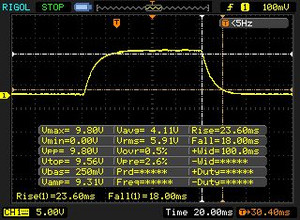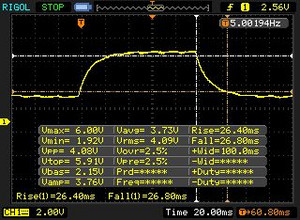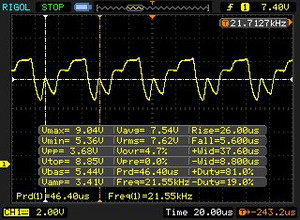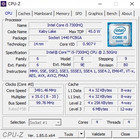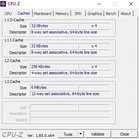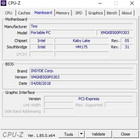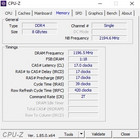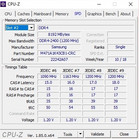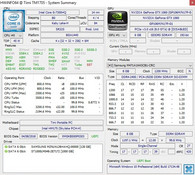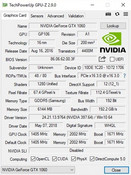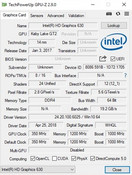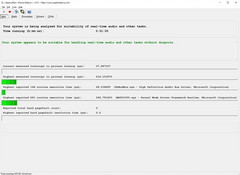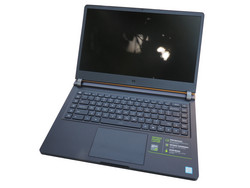Breve Análise do Portátil Xiaomi Mi Gaming Laptop (i5-7300HQ, GTX 1060, Full HD)
Os Top 10
» Os Top 10 Portáteis Multimídia
» Os Top 10 Portáteis de Jogos
» Os Top 10 Portáteis Leves para Jogos
» Os Top 10 Portáteis Acessíveis de Escritório/Empresariais
» Os Top 10 Portáteis Premium de Escritório/Empresariais
» Os Top 10 dos Portáteis Workstation
» Os Top 10 Subportáteis
» Os Top 10 Ultrabooks
» Os Top 10 Conversíveis
» Os Top 10 Tablets
» Os Top 10 Smartphones
» A melhores Telas de Portáteis Analisadas Pela Notebookcheck
» Top 10 dos portáteis abaixo dos 500 Euros da Notebookcheck
» Top 10 dos Portáteis abaixo dos 300 Euros
| SD Card Reader | |
| average JPG Copy Test (av. of 3 runs) | |
| Média da turma Gaming (20 - 210, n=70, últimos 2 anos) | |
| HP Omen 15-ce002ng (Toshiba Exceria Pro SDXC 64 GB UHS-II) | |
| Medion Erazer X6603 (oshiba Exceria Pro SDXC 64 GB UHS-II) | |
| Xiaomi Mi Gaming Laptop 7300HQ 1060 (Toshiba Exceria Pro SDXC 64 GB UHS-II) | |
| Dell Inspiron 15 7000 7577 (Toshiba Exceria Pro SDXC 64 GB UHS-II) | |
| maximum AS SSD Seq Read Test (1GB) | |
| Média da turma Gaming (25.5 - 261, n=67, últimos 2 anos) | |
| HP Omen 15-ce002ng (Toshiba Exceria Pro SDXC 64 GB UHS-II) | |
| Medion Erazer X6603 (oshiba Exceria Pro SDXC 64 GB UHS-II) | |
| Dell Inspiron 15 7000 7577 (Toshiba Exceria Pro SDXC 64 GB UHS-II) | |
| Xiaomi Mi Gaming Laptop 7300HQ 1060 (Toshiba Exceria Pro SDXC 64 GB UHS-II) | |
| |||||||||||||||||||||||||
iluminação: 87 %
iluminação com acumulador: 250 cd/m²
Contraste: 1230:1 (Preto: 0.23 cd/m²)
ΔE ColorChecker Calman: 4.68 | ∀{0.5-29.43 Ø4.77}
calibrated: 2.5
ΔE Greyscale Calman: 4.32 | ∀{0.09-98 Ø5}
87% sRGB (Argyll 1.6.3 3D)
57% AdobeRGB 1998 (Argyll 1.6.3 3D)
63.8% AdobeRGB 1998 (Argyll 3D)
87.3% sRGB (Argyll 3D)
66.6% Display P3 (Argyll 3D)
Gamma: 2.36
CCT: 7612 K
| Xiaomi Mi Gaming Laptop 7300HQ 1060 BOEhydis NV156FHM-N61 (BOE0747), IPS, 1920x1080 | Dell Inspiron 15 7000 7577 ID: LG Philips LGD053F, Name: 156WF6, Dell P/N: 4XK13, IPS, 1920x1080 | HP Omen 15-ce002ng AUO42ED, IPS, 1920x1080 | Acer Nitro 5 AN515-51-788E LG Philips LP156WF6-SPK6, IPS, 1920x1080 | Medion Erazer X6603 LP156WF6-SPK3, AH-IPS, LED, 1920x1080 | |
|---|---|---|---|---|---|
| Display | -40% | 2% | -33% | -41% | |
| Display P3 Coverage (%) | 66.6 | 37.07 -44% | 65.8 -1% | 41.7 -37% | 36.82 -45% |
| sRGB Coverage (%) | 87.3 | 55.6 -36% | 90.9 4% | 62.2 -29% | 54.9 -37% |
| AdobeRGB 1998 Coverage (%) | 63.8 | 38.32 -40% | 66.5 4% | 43.17 -32% | 38.09 -40% |
| Response Times | 34% | 22% | 41% | 22% | |
| Response Time Grey 50% / Grey 80% * (ms) | 53.2 ? | 35.6 ? 33% | 43.2 ? 19% | 35 ? 34% | 46 ? 14% |
| Response Time Black / White * (ms) | 41.6 ? | 27.6 ? 34% | 31.2 ? 25% | 22 ? 47% | 29 ? 30% |
| PWM Frequency (Hz) | 21550 ? | 2174 ? | |||
| Screen | -31% | 8% | -16% | -33% | |
| Brightness middle (cd/m²) | 283 | 235.4 -17% | 304 7% | 276 -2% | 252 -11% |
| Brightness (cd/m²) | 269 | 223 -17% | 289 7% | 265 -1% | 246 -9% |
| Brightness Distribution (%) | 87 | 91 5% | 86 -1% | 91 5% | 94 8% |
| Black Level * (cd/m²) | 0.23 | 0.28 -22% | 0.26 -13% | 0.25 -9% | 0.23 -0% |
| Contrast (:1) | 1230 | 841 -32% | 1169 -5% | 1104 -10% | 1096 -11% |
| Colorchecker dE 2000 * | 4.68 | 5.6 -20% | 3.46 26% | 5.06 -8% | 7.83 -67% |
| Colorchecker dE 2000 max. * | 8 | 20.3 -154% | 7.72 3% | 10.13 -27% | 15.5 -94% |
| Colorchecker dE 2000 calibrated * | 2.5 | ||||
| Greyscale dE 2000 * | 4.32 | 3.6 17% | 2.46 43% | 6.25 -45% | 7.11 -65% |
| Gamma | 2.36 93% | 2.23 99% | 2.38 92% | 1.76 125% | 2.19 100% |
| CCT | 7612 85% | 7214 90% | 6915 94% | 6873 95% | 7930 82% |
| Color Space (Percent of AdobeRGB 1998) (%) | 57 | 35.2 -38% | 59 4% | 40 -30% | 35 -39% |
| Color Space (Percent of sRGB) (%) | 87 | 55.4 -36% | 91 5% | 62 -29% | 55 -37% |
| Média Total (Programa/Configurações) | -12% /
-24% | 11% /
8% | -3% /
-12% | -17% /
-27% |
* ... menor é melhor
Exibir tempos de resposta
| ↔ Tempo de resposta preto para branco | ||
|---|---|---|
| 41.6 ms ... ascensão ↗ e queda ↘ combinadas | ↗ 23.6 ms ascensão | |
| ↘ 18 ms queda | ||
| A tela mostra taxas de resposta lentas em nossos testes e será insatisfatória para os jogadores. Em comparação, todos os dispositivos testados variam de 0.1 (mínimo) a 240 (máximo) ms. » 98 % de todos os dispositivos são melhores. Isso significa que o tempo de resposta medido é pior que a média de todos os dispositivos testados (20.2 ms). | ||
| ↔ Tempo de resposta 50% cinza a 80% cinza | ||
| 53.2 ms ... ascensão ↗ e queda ↘ combinadas | ↗ 26.4 ms ascensão | |
| ↘ 26.8 ms queda | ||
| A tela mostra taxas de resposta lentas em nossos testes e será insatisfatória para os jogadores. Em comparação, todos os dispositivos testados variam de 0.165 (mínimo) a 636 (máximo) ms. » 90 % de todos os dispositivos são melhores. Isso significa que o tempo de resposta medido é pior que a média de todos os dispositivos testados (31.6 ms). | ||
Cintilação da tela / PWM (modulação por largura de pulso)
| Tela tremeluzindo/PWM detectado | 21550 Hz | ≤ 99 % configuração de brilho | |
A luz de fundo da tela pisca em 21550 Hz (pior caso, por exemplo, utilizando PWM) Cintilação detectada em uma configuração de brilho de 99 % e abaixo. Não deve haver cintilação ou PWM acima desta configuração de brilho. A frequência de 21550 Hz é bastante alta, então a maioria dos usuários sensíveis ao PWM não deve notar nenhuma oscilação. [pwm_comparison] Em comparação: 53 % de todos os dispositivos testados não usam PWM para escurecer a tela. Se PWM foi detectado, uma média de 8084 (mínimo: 5 - máximo: 343500) Hz foi medida. | |||
| PCMark 8 Home Score Accelerated v2 | 3910 pontos | |
| PCMark 8 Work Score Accelerated v2 | 4912 pontos | |
| PCMark 10 Score | 4197 pontos | |
Ajuda | ||
| Xiaomi Mi Gaming Laptop 7300HQ 1060 Samsung PM871b MZNLN128HAHQ | Dell Inspiron 15 7000 7577 Samsung PM961 MZVLW256HEHP | HP Omen 15-ce002ng Samsung PM961 MZVLW256HEHP | Acer Nitro 5 AN515-51-788E Intel SSD 600p SSDPEKKW256G7 | Medion Erazer X6603 Samsung PM961 MZVLW256HEHP | |
|---|---|---|---|---|---|
| AS SSD | 165% | 29% | 175% | ||
| Seq Read (MB/s) | 502 | 2652 428% | 1404 180% | 2805 459% | |
| Seq Write (MB/s) | 450.1 | 1181 162% | 521 16% | 1081 140% | |
| 4K Read (MB/s) | 38.11 | 46.95 23% | 27.86 -27% | 46.58 22% | |
| 4K Write (MB/s) | 104.1 | 100.2 -4% | 75 -28% | 129.3 24% | |
| Score Read (Points) | 343 | 1241 262% | 446 30% | 1162 239% | |
| Score Write (Points) | 302 | 594 97% | 344 14% | 750 148% | |
| Score Total (Points) | 834 | 2405 188% | 984 18% | 2431 191% |
| 3DMark 11 Performance | 11106 pontos | |
| 3DMark Cloud Gate Standard Score | 16619 pontos | |
| 3DMark Fire Strike Score | 9249 pontos | |
Ajuda | ||
| The Witcher 3 - 1920x1080 Ultra Graphics & Postprocessing (HBAO+) | |
| Média da turma Gaming (18.4 - 240, n=54, últimos 2 anos) | |
| Xiaomi Mi Gaming Laptop 7300HQ 1060 | |
| Dell Inspiron 15 7000 7577 | |
| HP Omen 15-ce002ng | |
| Acer Nitro 5 AN515-51-788E | |
| baixo | média | alto | ultra | |
|---|---|---|---|---|
| The Witcher 3 (2015) | 72.8 | 40.3 | ||
| The Evil Within 2 (2017) | 36.5 | 35.1 | ||
| ELEX (2017) | 70.9 | 54 | ||
| Fortnite (2018) | 91.5 | 81.4 | ||
| Final Fantasy XV Benchmark (2018) | 39.8 | |||
| Kingdom Come: Deliverance (2018) | 43.6 | 36 | ||
| Far Cry 5 (2018) | 62 | 59 |
Barulho
| Ocioso |
| 30 / 34 / 38 dB |
| HDD |
| 32 dB |
| Carga |
| 44 / 55 dB |
 | ||
30 dB silencioso 40 dB(A) audível 50 dB(A) ruidosamente alto |
||
min: | ||
| Xiaomi Mi Gaming Laptop 7300HQ 1060 GeForce GTX 1060 Mobile, i5-7300HQ | Dell Inspiron 15 7000 7577 GeForce GTX 1060 Max-Q, i5-7300HQ | HP Omen 15-ce002ng GeForce GTX 1060 Max-Q, i7-7700HQ | Acer Nitro 5 AN515-51-788E GeForce GTX 1050 Ti Mobile, i7-7700HQ | Medion Erazer X6603 GeForce GTX 1050 Ti Mobile, i7-7700HQ | Média da turma Gaming | |
|---|---|---|---|---|---|---|
| Noise | 18% | 5% | 9% | 10% | 13% | |
| desligado / ambiente * (dB) | 30 | 28 7% | 30 -0% | 30.6 -2% | 30.9 -3% | 24.1 ? 20% |
| Idle Minimum * (dB) | 30 | 28 7% | 30 -0% | 30.6 -2% | 30.9 -3% | 26 ? 13% |
| Idle Average * (dB) | 34 | 28 18% | 33 3% | 30.7 10% | 30.9 9% | 27.7 ? 19% |
| Idle Maximum * (dB) | 38 | 28 26% | 37 3% | 30.7 19% | 31.6 17% | 30.2 ? 21% |
| Load Average * (dB) | 44 | 30.3 31% | 41 7% | 43 2% | 38.5 12% | 43.1 ? 2% |
| Witcher 3 ultra * (dB) | 50 | 39.5 21% | 42 16% | 39.7 21% | ||
| Load Maximum * (dB) | 55 | 46.5 15% | 50 9% | 45.8 17% | 40.8 26% | 53.7 ? 2% |
* ... menor é melhor
(-) A temperatura máxima no lado superior é 46 °C / 115 F, em comparação com a média de 40.4 °C / 105 F , variando de 21.2 a 68.8 °C para a classe Gaming.
(-) A parte inferior aquece até um máximo de 52 °C / 126 F, em comparação com a média de 43.3 °C / 110 F
(+) Em uso inativo, a temperatura média para o lado superior é 27.2 °C / 81 F, em comparação com a média do dispositivo de 33.9 °C / ### class_avg_f### F.
(±) Jogando The Witcher 3, a temperatura média para o lado superior é 37.1 °C / 99 F, em comparação com a média do dispositivo de 33.9 °C / ## #class_avg_f### F.
(+) Os apoios para as mãos e o touchpad são mais frios que a temperatura da pele, com um máximo de 28 °C / 82.4 F e, portanto, são frios ao toque.
(±) A temperatura média da área do apoio para as mãos de dispositivos semelhantes foi 28.8 °C / 83.8 F (+0.8 °C / 1.4 F).
| Xiaomi Mi Gaming Laptop 7300HQ 1060 GeForce GTX 1060 Mobile, i5-7300HQ | Dell Inspiron 15 7000 7577 GeForce GTX 1060 Max-Q, i5-7300HQ | HP Omen 15-ce002ng GeForce GTX 1060 Max-Q, i7-7700HQ | Acer Nitro 5 AN515-51-788E GeForce GTX 1050 Ti Mobile, i7-7700HQ | Medion Erazer X6603 GeForce GTX 1050 Ti Mobile, i7-7700HQ | Média da turma Gaming | |
|---|---|---|---|---|---|---|
| Heat | 13% | -11% | 16% | 18% | 1% | |
| Maximum Upper Side * (°C) | 46 | 44 4% | 47 -2% | 41.1 11% | 44.3 4% | 45.7 ? 1% |
| Maximum Bottom * (°C) | 52 | 43.8 16% | 54 -4% | 38.8 25% | 39.5 24% | 48.5 ? 7% |
| Idle Upper Side * (°C) | 32 | 26 19% | 36 -13% | 28.7 10% | 24.8 22% | 31.3 ? 2% |
| Idle Bottom * (°C) | 32 | 28 12% | 40 -25% | 26.9 16% | 24.6 23% | 34.2 ? -7% |
* ... menor é melhor
Xiaomi Mi Gaming Laptop 7300HQ 1060 análise de áudio
(+) | os alto-falantes podem tocar relativamente alto (###valor### dB)
Graves 100 - 315Hz
(±) | graves reduzidos - em média 13.5% menor que a mediana
(±) | a linearidade dos graves é média (8.5% delta para a frequência anterior)
Médios 400 - 2.000 Hz
(+) | médios equilibrados - apenas 4.6% longe da mediana
(+) | médios são lineares (5% delta para frequência anterior)
Altos 2 - 16 kHz
(+) | agudos equilibrados - apenas 2.6% longe da mediana
(+) | os máximos são lineares (4.4% delta da frequência anterior)
Geral 100 - 16.000 Hz
(+) | o som geral é linear (13.2% diferença em relação à mediana)
Comparado com a mesma classe
» 18% de todos os dispositivos testados nesta classe foram melhores, 4% semelhantes, 78% piores
» O melhor teve um delta de 6%, a média foi 18%, o pior foi 132%
Comparado com todos os dispositivos testados
» 13% de todos os dispositivos testados foram melhores, 3% semelhantes, 84% piores
» O melhor teve um delta de 4%, a média foi 24%, o pior foi 134%
Dell Inspiron 15 7000 7577 análise de áudio
(±) | o volume do alto-falante é médio, mas bom (###valor### dB)
Graves 100 - 315Hz
(±) | graves reduzidos - em média 13% menor que a mediana
(+) | o baixo é linear (6.8% delta para a frequência anterior)
Médios 400 - 2.000 Hz
(+) | médios equilibrados - apenas 2.7% longe da mediana
(+) | médios são lineares (5.3% delta para frequência anterior)
Altos 2 - 16 kHz
(±) | máximos mais altos - em média 8% maior que a mediana
(±) | a linearidade dos máximos é média (10.6% delta para frequência anterior)
Geral 100 - 16.000 Hz
(±) | a linearidade do som geral é média (18.9% diferença em relação à mediana)
Comparado com a mesma classe
» 63% de todos os dispositivos testados nesta classe foram melhores, 8% semelhantes, 29% piores
» O melhor teve um delta de 6%, a média foi 18%, o pior foi 132%
Comparado com todos os dispositivos testados
» 43% de todos os dispositivos testados foram melhores, 8% semelhantes, 49% piores
» O melhor teve um delta de 4%, a média foi 24%, o pior foi 134%
| desligado | |
| Ocioso | |
| Carga |
|
Key:
min: | |
| Xiaomi Mi Gaming Laptop 7300HQ 1060 GeForce GTX 1060 Mobile, i5-7300HQ | Dell Inspiron 15 7000 7577 GeForce GTX 1060 Max-Q, i5-7300HQ | HP Omen 15-ce002ng GeForce GTX 1060 Max-Q, i7-7700HQ | Acer Nitro 5 AN515-51-788E GeForce GTX 1050 Ti Mobile, i7-7700HQ | Medion Erazer X6603 GeForce GTX 1050 Ti Mobile, i7-7700HQ | Média da turma Gaming | |
|---|---|---|---|---|---|---|
| Power Consumption | 29% | -41% | 24% | 29% | -55% | |
| Idle Minimum * (Watt) | 10 | 7.1 29% | 18 -80% | 4.1 59% | 4.7 53% | 13.5 ? -35% |
| Idle Average * (Watt) | 13 | 7.6 42% | 23 -77% | 6.9 47% | 7.6 42% | 19.3 ? -48% |
| Idle Maximum * (Watt) | 19 | 8.6 55% | 30 -58% | 9.5 50% | 9.2 52% | 25.8 ? -36% |
| Load Average * (Watt) | 68 | 59.5 12% | 85 -25% | 83 -22% | 81 -19% | 110.9 ? -63% |
| Witcher 3 ultra * (Watt) | 110 | 89 19% | 96 13% | 108 2% | ||
| Load Maximum * (Watt) | 136 | 112.8 17% | 158 -16% | 126 7% | 112 18% | 260 ? -91% |
* ... menor é melhor
| Xiaomi Mi Gaming Laptop 7300HQ 1060 GeForce GTX 1060 Mobile, i5-7300HQ, 55 Wh | Dell Inspiron 15 7000 7577 GeForce GTX 1060 Max-Q, i5-7300HQ, 56 Wh | HP Omen 15-ce002ng GeForce GTX 1060 Max-Q, i7-7700HQ, 70 Wh | Acer Nitro 5 AN515-51-788E GeForce GTX 1050 Ti Mobile, i7-7700HQ, 48 Wh | Medion Erazer X6603 GeForce GTX 1050 Ti Mobile, i7-7700HQ, 45 Wh | Média da turma Gaming | |
|---|---|---|---|---|---|---|
| Duração da bateria | 48% | -19% | 46% | -18% | 48% | |
| Reader / Idle (h) | 6.4 | 11 72% | 4.3 -33% | 14.9 133% | 5.7 -11% | 9.62 ? 50% |
| H.264 (h) | 4.4 | 3.7 -16% | 5.2 18% | 3.8 -14% | 8.1 ? 84% | |
| WiFi v1.3 (h) | 4.6 | 6.9 50% | 3.3 -28% | 6.7 46% | 4.3 -7% | 6.78 ? 47% |
| Load (h) | 1.3 | 1.6 23% | 1.3 0% | 1.1 -15% | 0.8 -38% | 1.43 ? 10% |
Pro
Contra
Bens baratos do Extremo Oriente? Embora esse preconceito possa se encaixar em muitos produtos, não combina com o Mi Gaming Laptop. Na maioria das categorias, o portátil de 15 polegadas pode acompanhar facilmente a concorrência ou até superá-la.
Embora a carcaça não seja leve e existam portáteis de gama alta ainda mais finos, ficamos muito entusiasmados com a carcaça. O acabamento, a qualidade dos materiais e o design são irrepreensíveis. Os dispositivos de entrada e o som também se sentem melhor do que em alguns portáteis de 2000 ou 3000 Euros (~$2309-3464).
Mas, claro, nem tudo o que brilha é ouro. A fim de manter o preço atraente, a Xiaomi foi forçada a fazer alguns recortes em alguns detalhes, como o leitor de cartões, o lento desempenho do Wi-Fi ou a falta de certas conexões (Thunderbolt 3, Kensington Lock). Embora 8 GB de RAM e um SSD de 128 GB também sejam escassos, você também pode comprar o dispositivo em uma configuração com 16 GB e um SSD de 256 GB.
Mas poderíamos superar todos esses pontos, em nossa opinião. O que é claramente mais irritante é o alto nível de ruído na operação 3D e o comportamento dos ventiladores sem sentido, no modo inativo. Embora estes sejam fenômenos típicos em portáteis de jogos, os competidores geralmente permitem alivia-los através de ajustes manuais. Se você considera ou não a falta da tecnologia G-Sync como um ponto negativo, é uma questão de gosto. Em vez disso, a Xiaomi implementa o Optimus, o que ajuda a duração da bateria.
A tela deixa alguns sentimentos contraditórios. Por um lado, gostamos do alto contraste e dos ângulos de visão estáveis, mas, por outro lado, alguns dos atuais critérios de gamers (120/144 Hz, tempo de resposta curto) permanecem desatendidos. Antes da compra, você também deve saber que, devido ao software chinês, o Mi Gaming Laptop destina-se apenas de forma limitada para o mercado da UE ou dos EUA. No entanto, aqueles que não se assustam com os obstáculos da entrada e têm a sorte de receber uma unidade diretamente ou através de alguns desvios, receberão um pacote geral bem-sucedido a preço de banana.
No final do dia, o perdedor avança para uma dica privilegiada e consegue uma colocação alta em nossa lista dos 10 melhores portáteis de jogos de orçamento.
Xiaomi Mi Gaming Laptop 7300HQ 1060
- 05/28/2018 v6 (old)
Florian Glaser







